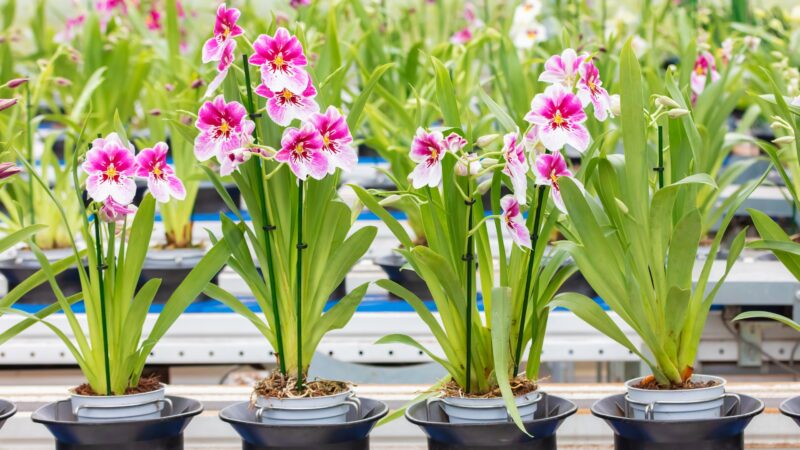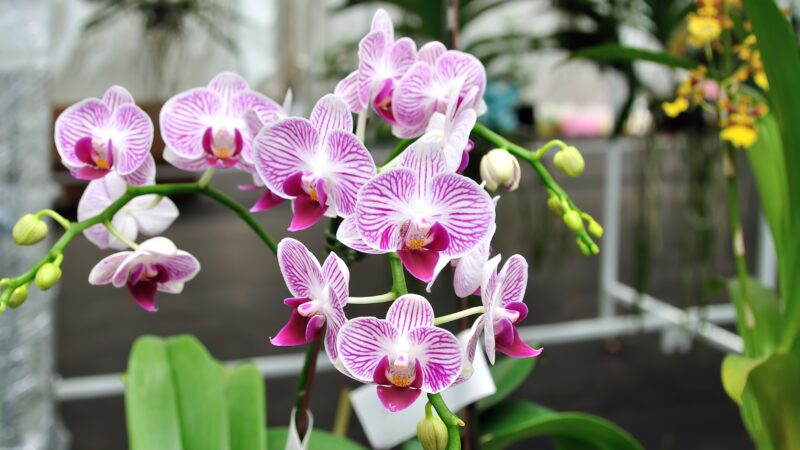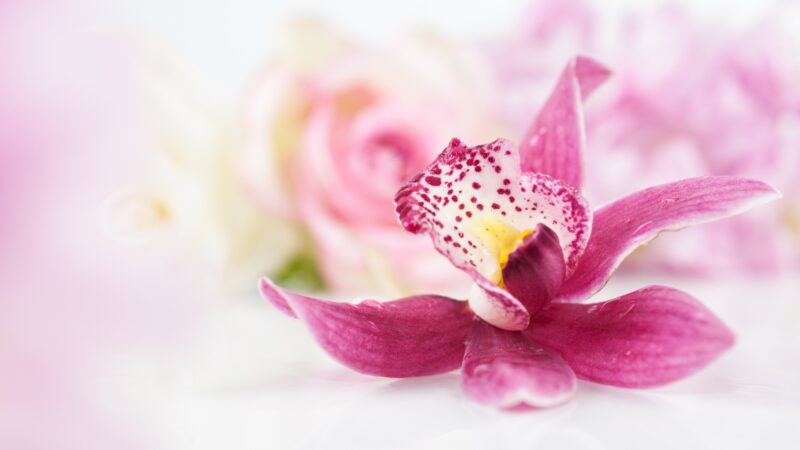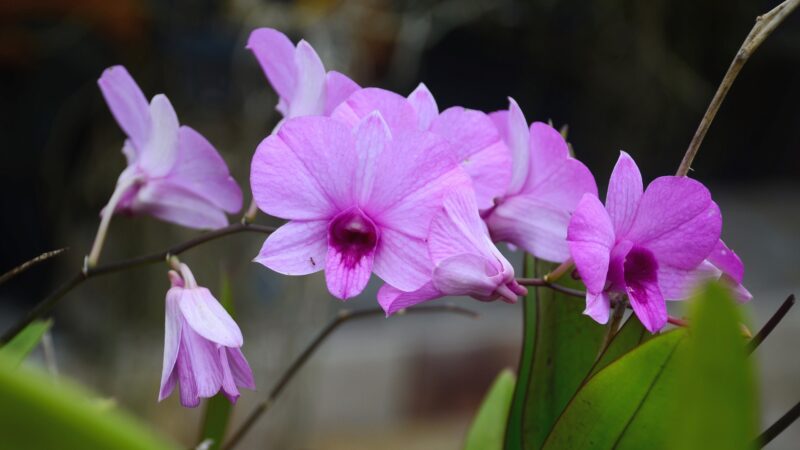With their lovely pastel-colored flowers and linear bud clustering, orchids can make any home or garden look more appealing. There’s also something about them that can make you feel calm.
But, did you know that this plant can also suffer from stress? In fact, it’s one of the reasons for its flowers falling off. If you don’t want that to happen to your beloved orchid, then continue reading this article.
Before anything else, why are your orchid flowers falling off? There are 7 reasons why orchid flowers fall off:
- It is being overwatered.
- It is experiencing drought stress.
- It is receiving too much or insufficient light.
- It is experiencing fluctuating temperatures and humidity from its surroundings.
- It is suffering from transplant shock.
- It has been overfertilized.
- There is a pest infestation.
Fortunately for you, this article doesn’t just list down the reasons why orchid flowers fall off. Instead, you’ll also learn how to resolve the issue so you can save your orchid from dying completely. You’ll also learn other orchid facts, including tips and tricks on how to take care of this beautiful plant.
Introduction to Orchid Flowers

There’s no denying that orchids are among the most popular plants out there. With around 30,000 known species of this flowering plant, you’re bound to find one wherever you may be in the world.
Orchids are known for their flowering clusters and sweet, musky fragrance, so it’s easy to see why they became popular. Their flowers usually come in pastel colors and can last for up to 120 days in a year – although it still depends on the orchid variety. As such, it can surely add a pop of color to any garden or indoor space.
Orchid Life Cycle
To understand why orchid flowers fall off, you have to gain an insight into an orchid’s life cycle first. Like most plants, there are six stages in an orchid’s life cycle. This starts with planting seeds and ends with the seed spreading of the new orchid.
- Seed planting. An orchid’s life begins when its seeds are planted in the soil. Alternatively, new orchids may also begin from cuttings through propagation.
- Germination. Germination is the stage where the seeds or cuttings will start to grow roots and grow new sprouts. This is one of the longest stages in an orchid’s life and may even take a few years, depending on the orchid variety. But on average, orchid seed or cutting may sprout within a month or two.
- Growth. Once the seed has sprouted, it will take a year or two to grow into a mature plant. During this stage, the orchids start to develop their sturdy stems, leaves, spikes, and buds. During this stage, orchids will be moved into bigger pots to allow their roots to spread better.
- Flowering. This is perhaps the most beautiful stage in the life cycle of an orchid. During this stage, its flowers start to bloom, giving off lovely colors and an attractive sweet fragrance.
- Pollination. With the orchid now at maturity, it is now ready for pollination. The orchid will try to attract pollinators like bees and wasps so that its pollen can reach other flowers. Some orchid varieties use nectar, while others make use of their petals to attract their pollinators.
- Seed release. After successful pollination, the ovary behind the orchid flower will begin to swell. Within 10 months, it will split open at maturity to spread tiny orchid seeds – and the cycle begins anew.
How Long Orchid Flowers Last?

On average, an orchid flower lasts for around 120 days. However, some orchid varieties only have flowers lasting between two to four months before they fall off naturally. And in both instances, these flowers will bloom again in the following year.
How Often Orchids Bloom?
A healthy mature orchid blooms once a year. These flowers usually last for two to four months before falling off, and the orchid goes into hibernation when the temperatures become too cold. Then, they start to bloom again once the temperatures drop, usually in the spring of every year.
Is it Normal for Orchids to Lose Flowers?

Orchids may lose flowers naturally as part of their life cycle. On average, an orchid flower lasts for only three months or 120 days, after which it will start to wilt and fall off eventually. This is especially true in the case of healthy orchids.
Should You Cut the Orchid After Flowers Fall Off?
It would depend on the reason why the flower fell off. If the flower fell off because it’s part of its natural life cycle, then there’s no need to cut the stem. The only exception, in this case, is if the stem is already too long – then it’s time to prune it to a more suitable length.
In contrast, if the flower fell off because of an underlying condition of the orchid, then there is a need to cut off the stem. This is especially true if the stem looks wilting, rotting, or damaged in any way.
By cutting this unhealthy part off, you’re allowing your orchid to focus all its resources on staying healthy – instead of stressing itself out to revive its damaged parts.
Why Are My Orchid Flowers Falling Off?

Overwatering
Orchids do not need a lot of water to survive. In fact, some orchid species can survive for up to three weeks without water. But to keep your orchid healthy, it needs light misting once a week – an amount that’s equivalent to three ice cubes would suffice.
If orchids are given too much water, they will start to look droopy. Its leaves and stems will also become soft and mushy. When the stem becomes too soft, the flowers will become too heavy for it. As a result, the flowers will eventually fall off.
Solutions: In the case of an overwatered orchid, the best way is to place it where it can receive sunlight to help dry up the soil.
However, if the orchid looks very soaked, the best option is to transfer it to a new pot with dry soil to help the roots dry up faster. Then, water it once the roots are dry enough. This is usually a few days after it has been transferred to the new pot.
Drought Stress
Like all plants, orchids need water to survive. It only needs light misting once a week. If it doesn’t get enough water, it experiences drought stress.
Since water helps the roots absorb the nutrients from the soil, not getting enough water leads to the orchid not getting the nutrients it needs to stay healthy. As a result, its leaves will start to look dry and wrinkled, and its flowers may also start to fall off.
Solutions: In the case of drought stress, the best way to help it recover is to shower it with an inch of water and allow it to seep into the soil. Do so once a week until it has fully recovered.
Once recovered, you can go back to spraying it lightly with water once a week. During this recovery period, make sure it still gets enough indirect sunlight.
Too Much/Insufficient Light
Orchids need sunlight to make their flowers bloom. Preferably, they need bright yet indirect sunlight for around six to eight hours.
If they are to be exposed to direct sunlight, make sure it doesn’t exceed two hours. Otherwise, this might cause its flowers to fall off and its leaves to turn brown and dry.
In contrast, when it is not getting enough light, the flowers might also fall off, and its leaves will turn a pale yellow. Since the orchid is not getting enough nutrients from the sun, it will fail to make its flowers bloom.
Solutions: If the orchid is getting too much light, the best solution is to place it in a shaded room for a while. This allows you to control how much light it’s getting so as not to dry it out. While it is recovering, make sure to water it like you usually would keep it hydrated and healthy.
If the orchid is not getting enough light, then you can move it to a place where it can get bright yet indirect sunlight. If it has been raining for a while, you may opt to use a lamp like the Grow Lights for Indoor Plants, which is specifically designed to provide light for indoor plants.
- Adjustable gooseneck and telescopic pole: The flexible gooseneck...
- White & red LED lamp beads: Simulating natural light, especially...
- Efficient full-spectrum LED lamps: The plant growing light has 72...
- Designed for plant growth: This plant growth lamp can meet the...
- Multiple usage: You can put it on the balcony, living room,...
Fluctuating Temperature and Humidity
Orchids are tropical plants and therefore thrive where it is warm and humid. Its ideal temperature ranges between 65 to 75 degrees Fahrenheit, while its ideal humidity is between 40 and 70%.
When the temperature drops below its ideal range, orchids will start to look pale and droopy. If it is exposed to the cold for prolonged periods, it might also start to lose its flowers. And if the temperature drops to freezing points, it might eventually die.
In contrast, if the temperature is too hot – as in the case of a heat wave – your orchid might also suffer from dehydration. This results in fallen leaves and flowers, as well as an overall wilting appearance for your orchid.
Solutions: If there have been fluctuating temperatures and humidity in your area lately, the best solution is to move your orchid indoors where you can control the temperature and humidity.
As much as possible, make sure to set the temperature between 65 to 75 degrees Fahrenheit and the humidity to be not lower than 40%. Make sure it also receives bright yet indirect sunlight for six to eight hours, as well as enough water once a week.
Transplant Shock
To allow an orchid to grow into a healthy plant, it will need to be repotted once a year. Moving the orchid to a bigger pot will allow its roots to grow freely and fully absorb the nutrients in the soil.
In doing so, you must be careful. Otherwise, careless repotting often leads to transplant shock. It takes place when the roots are damaged while moving the orchid to another plant, coupled with the orchid’s adjustment to its new environment.
When an orchid experiences transplant shock, it usually results in its flowers falling off. At times, it also causes it to lose its leaves.
Solutions: Fortunately, transplant shock is merely temporary. In about three to four weeks, the orchid will be able to adjust to its new pot and environment.
In the meantime, make sure not to stress your orchid further, so make sure that it still gets enough water and sunlight. It also helps to monitor the temperature and humidity to make sure it doesn’t dry out completely.
Overfertilized
Fertilizers can help orchids bloom, especially when fed in moderate quantities. But as the saying goes, too much of something is bad for you – and the same is true when you give too much fertilizer to an orchid.
When an orchid is overfertilized, its roots can be damaged or burned. This results in the poor absorption of nutrients from the soil. And when the orchid isn’t getting the nutrients it needs, it does not take long for it to become weak and die eventually.
Solutions: When an orchid is overfertilized, the simplest solution is to water it with distilled water. Distilled water will help dilute the excess fertilizer and serve to flush away the excess from the pot.
Alternatively, if the damage to the roots is already severe, you may opt to transfer your orchid to a new pot. Make sure to use new soil as well.
Pest Infestation
Another reason why orchid flowers fall off is a pest infestation. As plants, orchids are at the bottom of the food chain – with common predators including thrips, spider mites, mealybugs, and aphids.
Unfortunately, these pests tend to suck the sap from these orchids. These plant sap carry the nutrients from the soil to the different parts of the orchid.
Since pests already consumed the sap, no more nutrients are left for the flowers. This results in the flower wilting and falling off eventually.
Solutions: The best solution to a pest infestation is to spray your orchid with an insecticidal soap like the Bonide Insecticidal Soap.
- Captain Jack's Insecticidal Super Soap controls species of...
- Designed for outdoor residential use in home gardens, lawns,...
- Product kills through direct contact and ingestion; spray...
- Approved for organic gardening, Captain Jack's Insecticidal Super...
- Product is conveniently ready-to-use when it arrives at your...
Insecticidal soaps not only kill these pests when sprayed directly, but it also prevents another infestation within a few months. Then, simply spray the orchid again during the late spring or summer months – months when pests are most active – as prevention.
Also, if the damage done by these pests is too severe, it is best to remove these damaged parts to keep your orchid from being stressed.
Orchid Care After Flowers Fall Off
Remove the damaged part, if any. If the orchid flowers fell off because the plant is damaged, then it’s best to remove the damaged part as well. If the damaged part is not separated from the healthy parts, then the orchid will continue to work hard to restore it back to health.
While that may not be a problem in case of minimal damage, it can be quite stressful for the orchid if the damage is too severe – especially if parts of it have already started to rot.
Continue to water it regularly. Whether or not the reason for the flowers falling off is completely natural or not, continue to care for your orchid as you usually would. Make sure to give it the right amount of water every week to keep it from becoming dehydrated or overwatered.
Feed it with fertilizer. To make sure that your orchid will flower again, you may feed it with fertilizer. The Sun Bulb Company 8305 Better Gro Orchid Plus Bloom Booster Fertilizer, which specifically helps orchids bloom, is a good fertilizer to consider. For best results, you should feed your orchid fertilizer during its active season, which is around springtime.
- Orchid plus bloom booster fertilizer
As much as possible, try to maintain its ideal environment. Aside from giving it water and fertilizer, it also helps to make sure that it is in an environment that is not stressful to it.
As tropical plants, orchids love humid and warm environments. Thus, keep the temperature between 65 to 75 degrees Fahrenheit and the air moisture content levels between 40 to 70%.
How to Prevent the Orchid Flowers From Falling Off?
Identify the main causes why orchid flowers fall off unnaturally. If you are familiar with these conditions and their causes, then you can use that knowledge to prevent them from happening in the first place.
Water regularly, giving usual amounts only. Orchids do not need much water to survive. At most, it needs around three ice cubes worth of water per week.
Sometimes, they can also survive for ten days without being sprinkled with water. With that in mind, make sure to only give it that much water, otherwise you risk it being overwatered or dehydrated.
Take note of the temperature. As tropical plants, orchids love warmth. It prefers a daytime temperature of 75 degrees Fahrenheit or warmer, as well as a nighttime temperature of 65 degrees Fahrenheit or warmer.
If the temperature drops and the orchid is exposed to cool temperatures for extended periods, it might end up looking pale and droopy. Thus, always monitor the temperature around your orchid to prevent its flowers from falling off.
Humidity. Aside from humidity, it also helps to monitor the humidity levels surrounding the orchid. For best results, it has to be around 40 to 70%.
If the air becomes too dry, the orchid closes its stomata – the part, which is responsible for absorbing carbon dioxide. This is akin to an orchid stopping its breathing. To prevent this from happening, you can use pebbles like the Organic Expanded Clay Pebbles Grow Media around your orchid to help it retain moisture in the air.
- PREMIUM QUALITY INGREDIENTS: Cz Garden Clay Pebbles are high...
- ORGANIC GARDENING - Cz Garden Clay Pebbles are all natural and...
- BENEFITS: Provides excellent aeration, improves drainage, and...
- ORCHIDS: for planting or repotting a pleathora of orchids...
- HYDROPONIC HEAVEN: Cz Garden Clay Pebbles are the #1 Substrate...
Light source. While orchids love basking in the sunlight for up to eight hours, they are prone to developing sunburn if it is directly exposed to the sun.
With that said, always keep your orchids in a shaded area where they can still receive indirect sunlight from the sun for six to eight hours. After that, you can move it indoors for the remainder of the day.
Careful handling. Orchid flowers also fall off when they are mishandled during repotting. In this case, make sure to do so carefully so as not to damage any part of it – especially the roots.
List of Sources
Orchids – https://hgic.clemson.edu/factsheet/orchids/
Growing Orchids in the Home – https://extension.tennessee.edu



